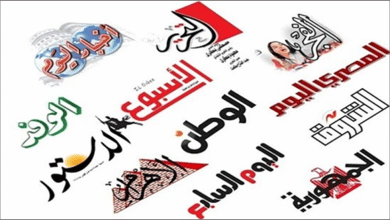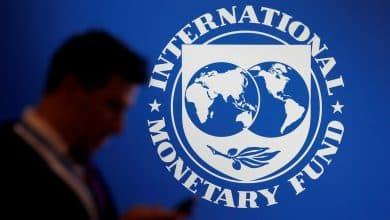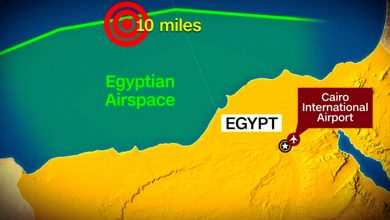
Egypt: Impact of water shortage on the food gap
Egypt: Impact of water shortage on the food gap
The issue of food security is one of the most dangerous weapons used by the major powers against the developing countries, where it is used as a pretext for practicing pressure on these countries to prompt them to comply with their conditions and implement their policies, which leads most developing countries to fall a prey to economic dependency.
The agricultural sector is considered one of the most important sectors for any country trying to reduce its food gap and achieve self-sufficiency in food crops. Given that the water resources represent the cornerstone of the agricultural sector, this paper will address the impact of the shortage of water resources on the food gap in the country, mainly the wheat crop, in light of the construction of the Grand Ethiopian Renaissance Dam, and the likely drop in Egypt’s Nile water share.
The paper will focus on the wheat crop as an important model in this regard, going through the agricultural policies adopted by the government related to the cultivation of wheat as the most significant strategic crop in Egypt.
The issue of water resources is one of the thorny issues in Egypt, as it is the considered the cornerstone of all economic sectors and a key driver in the Egyptian economic development processes.
In light of the recent water challenges and the low share of Egypt from the Nile River water, as a result of the construction of the Grand Ethiopian Renaissance Dam, the water shortage will pose a threat to both Egypt’s water security and food security, given the fact that the agricultural sector is the main consumer of water resources in Egypt, about 77%, which highlights the great impact of water shortage on food security in Egypt.
Uses of water resources in Egypt
The uses of water resources in Egypt are divided into: drinking water, industrial water, agricultural water, and finally the share of evaporated water. The use of water by the agricultural sector in Egypt is about 61.65 billion m3 / year out of a total of 80 billion m3 / year, Egypt’s water share.
Egypt is classified among the water poor countries, especially after the emergence of the crisis of construction of the Renaissance Dam in Ethiopia, which in turn greatly affects the issue of the country’s food security, taking into account that Egypt suffers from a food gap of more than 55% of its food needs.
A study published by the Egyptian Journal of Agricultural Economics draws three scenarios for the consequences of filling the Grand Ethiopian Renaissance Dam on the Egyptian agricultural sector, as follows:
The first scenario, which is the most optimistic scenario for Egypt, in case the dam is filled within ten years after completion of its construction, which deprives Egypt of about 10 billion m3 of Nile River water, with a likely drop in the crop area of 9.13 million feddans, an annual 3-million-feddan loss of the crop area.
The second scenario, in case the dam is filled within six years, where it deprives Egypt of about 17 billion m3, and the crop area is expected to decrease to 4.85 million feddans, with a loss of 7.3 million feddans annually, which is the most likely scenario as a compromise between Egypt and Ethiopia.
The third scenario, in case the dam is filled within three years, which deprives Egypt of about 33 billion m3, and the crop area is expected to decrease to 2.96 million feddans, with a loss of about 9.2 million feddans annually. However, this scenario is the most pessimistic scenario with the most annual water and crop losses for Egypt.
This study of the Egyptian Journal of Agricultural Economics finds out that the Renaissance Dam will lead to widening the gap between production and consumption of some important crops such as wheat, corn, rice, sugar and oils, and reducing the crop areas included in agricultural manufacturing industries such as rice, oils, corn, cane, cotton, textiles, dyeing and tanning, in addition to animal and fish production.
Hence, it is clear that the scarcity of water resources, especially after the construction of the Grand Ethiopian Renaissance Dam greatly affect Egypt’s food security and leads to expansion of the food gap in the agricultural country.
The wheat crop as a model
Wheat is one of the most important food crops that Egyptians daily rely on to obtain the calories their bodies need.
The average per capita share of grain in Egypt in 2019 was estimated by the Central Agency for Public Mobilization and Statistics (CAPMAS), at about 272.6 kg, of which 153.3 kg were from wheat only, where wheat accounts for 56 percent of the total grain consumption in Egypt annually. This shows the significance of the wheat crop as an important strategic commodity in the country.
Despite the importance of the wheat crop in Egypt, the country suffers from a large food gap related to the crop, where domestic production cannot keep pace with the continuous increase in population numbers. Therefore, the government resorts to importing from abroad to fill the existing wheat gap, which is evident in the following data:
(Quantity: in million tons) (Area: in million feddans)
| Year | Production | Imports | crop area | Self-sufficiency rate (%) |
| 2006/2007 | 7.4 | 7.0 | 2.7 | 53.5 |
| 2007/2008 | 8.0 | 7.55 | 2.9 | 54.8 |
| 2008/2009 | 8.5 | 9.93 | 3.1 | 74.4 |
| 2009/2010 | 7.2 | 10.05 | 3.0 | 40.5 |
| 2010/2011 | 8.4 | 10.14 | 3.0 | 48.8 |
| 2011/2012 | 8.8 | 11.5 | 3.2 | 55.7 |
| 2012/2013 | 9.5 | 8.5 | 3.4 | 56.7 |
| 2013/2014 | 9.3 | 10.5 | 3.4 | 53.1 |
| 2014/2015 | 9.6 | 11.314 | 3.5 | 49.1 |
| 2015/2016 | 9.3 | 12,068 | 3.4 | 47.7 |
| 2016/2017 | 8.4 | 11.172 | 2.9 | 34.5 |
| 2017/2018 | 8.3 | 12.4 | 3.2 | 35.5 |
| 2018/2019 | 8.6 | 12.5 | 3.1 | 40.3 |
| 2019/2020 | 8.0 | 12.6 | 3.4 | – |
Sources: 1) United Nations Food and Agriculture Organization (FAO) 2) Central Agency for Public Mobilization and Statistics (CAPMAS), 3) The Egyptian Ministry of Agriculture and Land Reclamation.
– The above table shows the quantities of wheat produced in Egypt during the study period (2006-2020), where production has been increasing extremely slowly throughout the period. Wheat production in FY2006/2007 was 7.4 million tons, then rose to 8 million tons in FY2007/2008, then to 8.5 million tons in 2008/2009, but it decreased to 7.2 million tons in FY2009/2010, and it continued to fluctuate between a slight increase and decrease during the period 2010 to 2014, until it reached its maximum value in FY2014/2015, when it reached 9.6 million tons. However, it fluctuated again, dropping to about 8 million tons in FY2019/2020.
– Therefore, there is an increase in wheat imports during the study period to cover the wheat gap in Egypt, where wheat imports in FY2006/2007 were about 7 million tons, and rose to about 7.55 million tons in 2007/2008, then up to 9.93 million tons in FY2008/2009, and continued to increase, with the exception of the fiscal year 2012/2013, when wheat imports decreased to 8.5 million tons, by 26%, due to late President Mohamed Morsi’s plan to reduce wheat imports and increase production to achieve self-sufficiency within four years. However, after the coup in mid-2013, wheat imports rose again, and they kept rising, up to 12.6 million tons in FY2019/2020.
-It is certain that the increase in Egypt’s wheat import bill significantly increases the state’s trade balance deficit. However, the wheat self-sufficiency rate in Egypt is still low, except for the year 2008/2009, where wheat self-sufficiency reached 74.4%; otherwise, wheat self-sufficiency is around 50%, and has recently reached nearly 40%, which shows the extent of the wheat gap in Egypt.
-The above data also shows the wheat crop area in Egypt, which is also moving at a very slow pace that does not go in line with the growing population in Egypt. The wheat crop area in FY2006/2007 was about 2.7 million feddans, then rose to 2.9 million feddans in 2007/2008, an increase rate of about 7.4%; then it rose to 3.1 million feddans in FY2008/2009, an increase of 6.8%; and thus it continued to increase or decrease by a small rate until it reached about 3.4 million feddans in FY2019/2020. Thus, we see that the wheat crop area has increased during the period from 2006 to 2020 at a rate of 25.9%, while the population has increased at a rate of about 40%; given that the population in Egypt in 2006 was about 71.3 million, and in 2020 it reached about 99.8 million, according to the data of the Central Agency for Public Mobilization and Statistics.
Impact of wheat gap
The Egyptians have made several economic decisions for reducing subsidies in recent years, as preliminary steps to permanently lift subsidies altogether. In fact, these successive decisions test the extent of the Egyptian street’s tolerance and acceptance of the allegedly economic openness policies imposed by the International Monetary Fund, including raising prices of fuel, electricity, gas, and public transportation. Finally, Sisi came out to declare his intention to reduce subsidies on bread, raising its price by 300%. The Ministry of Supply and Internal Trade also announced that it was studying that decision to start implementing it soon.
Despite reducing the number of the beneficiaries of bread subsidies to 71 million beneficiaries, compared to 81 million last year, according to the CAPMAS data, in addition to reducing the weight of the loaf of bread from 130 grams to 110 grams and finally to 90 grams, however, the state tended to transgress the red lines and overburden the low-income segments of Egyptians. It is certain that the loaf of bread for the Egyptians is considered one of the most essential commodities for consumption, whether for the rich or the poor; however, despite Sisi’s previous statements that he would not touch the price of the loaf of bread, yet he broke his vow as he used to do again and again.
Many economists confirm that the decision to reduce subsidy on the loaf of bread came within the framework of implementing the terms of the International Monetary Fund, taking into mind that Egypt is faltering in repayment of the public debt to the International Monetary Fund, which is close to $20 billion. Therefore, the government is keen on implementing the IMF conditions to ensure its funding with more loans. However, the low-income Egyptian citizen remains a prey to the consequences of the successive austerity economic decisions that have increased his impoverishment, where every time such decisions are passed using the tight security grip imposed on the Egyptian people.
The Minister of Supply also announced that the subsidy item for food commodities in the general budget rose during the fiscal year 2021-2022 to EGP87.2 billion, compared to EGP84.4 billion in FY2020/2021, adding that the subsidy directed to the loaf of bread increased from EGP48 billion last year to about EGP51 billion.
In fact, this increase is a natural result of the rise in food prices, and not to increase the prosperity, development and welfare of citizens. Rather, it is considered a small increase, amid waves of high prices, inflation and high unemployment rates in the country.
Also, decisions to reduce subsidies must be accompanied with an increase in the level of per capita income and an increase in salaries, in order to relieve citizens of the consequences of these austerity decisions, in light of the high prices of fuel, electricity, gas, and public transportation. However, this has not happened, which pushes more Egyptians below the poverty line.
In addition, the largest proportion of the budget deficit is not due to subsidies, but rather due to the increase in the public debt, which devours about 64% of the uses of the public budget in the form of repayment of the debt and its service. However, reducing the budget deficit should not be at the expense of ordinary citizens, but by reducing loans from the IMF and others to reduce the burden of its interest on the public budget.
Agricultural policies
The faltering agricultural policies are considered among the most important causes of the crisis of wheat gap in Egypt, which proves the lack of the political will on the part of the ruling regime to reduce the severity of this crisis. These policies include:
-Supporting farmers: where the government has abandoned subsidizing Egyptian farmers, which is evident in the reduction of the item of farmers’ support in the state’s general budget, where this subsidy in FY2017/2018 was about EGP1.065 billion , and similarly in FY2018/2019, but it decreased in FY2019/2020 to EGP565 million, by 46.9%, which is a very large decrease that reflects the state’s lack of interest in the agricultural sector or will to reduce the food gap in Egypt. Finally, farmers’ support in FY2020/2021 budget rose to EGP565 million, an increase of only EGP100 million.
-Pricing of domestic wheat: Although the quality of Egyptian wheat is equivalent to the quality of American wheat, the price of Egyptian wheat that the government buys from farmers is lower than the price of imported American wheat, which reflects the extent of bias for imported wheat at the expense of domestic wheat.
-Geographical concentration of wheat imports: Egypt imports wheat from countries, including: Russia, the United States, Ukraine, France, Romania, Australia and others, where Egypt’s wheat imports were estimated last year at about 12.6 million tons. However, the Russian wheat alone accounted for 49% of wheat imports, with the rest distributed among Ukrainian, Romanian, American and French wheat. This geographical concentration of wheat imports to Egypt certainly leads to exposing the country to Russian pressure to a large extent.
Conclusion
Egypt suffers from a large food gap in several essential crops, where the problem of water scarcity in Egypt is one of the most important challenges facing food security, especially after the construction of the Grand Ethiopian Renaissance Dam and the resulting drop in Egypt’s share of the Nile River water, and accordingly a drop in the cultivated areas, which will certainly affect the issue of food security in Egypt and pose a threat to the country’s national security, in light of the already worsening wheat gap problem in Egypt.
In fact, the wrong economic policies adopted by the successive Egyptian governments had a significant impact on widening the gap between the supply and demand of the wheat crop in Egypt. The state has abandoned support of the Egyptian farmer in wheat cultivation, which made farmers abandon growing wheat, due to the high production costs and low profit margin, amid the low pricing of domestic wheat that is announced at the end of the wheat growing season.
Also, the geographical concentration of Egypt’s imports of wheat played a role in the continued dependence on certain countries, where Egypt’s dependence on a particular country to cover its consumption of an important strategic crop like wheat is one of the most dangerous economic policies adopted by the government.
Finally, putting an end to the wheat gap and the realization of the dream of self-sufficiency in wheat can be only achieved through a serious political will from the ruling regime and keenness on ensuring economic independence, in addition to the active oversight of state agencies to curb the rampant corruption that devours the country’s wealth.
لقراءة النص بصيغة PDF إضغط هنا.

